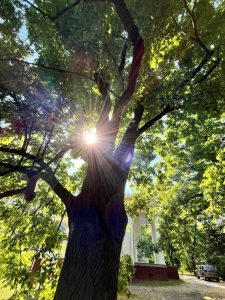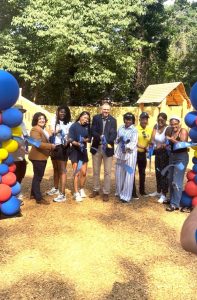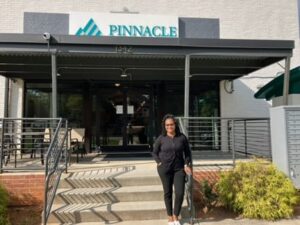By Nancy Leighton
Outspoken community member Cary Rufus Duncan Jr. passed away earlier this year on May 10, 2014 at age 74. He lived in the neighborhood since he was a small child. As an adult, he was intensely interested in various issues and changes going on in this area. If he had an opinion on a topic, he made sure to speak up and tell people what he thought.
He was a member of the Grant Park Neighborhood Association (GPNA) from the time it was first organized. He spoke out at the Neighborhood Planning Unit W (NPU-W) meetings. He went downtown to testify at the Board of Zoning Adjustment (BZA) hearings and the Zoning Review Board (ZRB) hearings. It was not unusual for him to take his concerns to city council members, to committees of the city council, and the city council as a whole. Local television stations had reporters at these meetings; and, more than a few times, they filmed him making comments and later broadcast his remarks on air.
Cary Rufus Duncan was born on September 8, 1939 in Troup County, Georgia. His parents were Winnie Parham Turner and Cary R. Duncan Sr. Cary went by his middle name Rufus throughout his youth. When Cary was a little boy, the family moved to Grant Park and bought a big house on the corner of Milledge Avenue and Oakland Avenue. Cary went to Hoke Smith High School.
Hoke Smith High School was the segregated high school for white students. The school was located at 537 Hill Street between Milledge Avenue and Sydney Street. The school was integrated in the 1960s when the rest of the Atlanta Public Schools integrated, and it was in use until the mid-1980s. Very shortly after its last school year, the demolition crew came in and razed the building, leaving the large open lot now seen in that spot. The school’s gymnasium building is still there at Milledge Avenue and Hill Street and is being used by the Boys and Girls Club.
Living close, Cary walked to school every day. He was a good student and well-liked. He was associate editor for the school newspaper, was in the Beta Club and National Honor Society, and was the valedictorian of his class in 1958. Unlike many students who got top grades, Cary did not go to college. Instead he went into banking, and that later lead him into various types of investments.
At the time Cary graduated from high school, the age of the houses in Grant Park ranged from 60 to 85 years old. The oldest of those houses had no original plumbing or wiring. Those utilities had to be patched in later. The early 20th century houses had original plumbing from that time period and nob and tube wiring which had become outdated by the 1950s. The houses were outdated in other ways. Many hadn’t been painted regularly or recently. They had ramshackle porches with falling railings, broken and boarded-up windows and battered door and window trim and siding. It was not a pleasant area to visit or live in.
There were many communities throughout the United States with similar deteriorating conditions. The Federal government was aware of these blighted areas and wanted to do something to improve these neighborhoods. They called their programs “Urban Renewal.” One of the biggest Urban Renewal projects was the creation of the Interstate Highway System. Planning and surveying for the Interstate Highway System was already under way in the mid-1950s. Nearly a square mile of homes and businesses were demolished to make room for the interchange of I-75, I-85, and I-20 south of the downtown area. The destruction continued through north Grant Park, north Ormewood Park, East Atlanta, westward toward West End and south. Grant Park, as we know it today, is only a small remnant of the housing stock that was lost in the creation of the Interstate Highway System. The Interstates through Atlanta opened in the mid-1960s.
It was about ten years after that when some younger folks began to notice the old neglected houses in Grant Park. Behind the peeling paint, rotted siding, and holes in the roofs, they could see the inherent charm and wonderful details of the old houses. They began to buy these houses at rock-bottom prices. With a few thousand dollars, they could make a down payment and live in the home while they worked on it. Cary Duncan bought old houses at those prices too. He fixed up some of the homes to sell, and he rented out some of the other houses.
These young people faced a lot of obstacles. Banks designated large areas of the south side of town as crime-ridden slums. Many of the neighborhoods south of Ponce de Leon were red-lined, and banks would not lend money for repairs or for new construction. This in part led to the creation of the Grant Park-SAND Credit Union. In addition, new residents faced opposition to moving to Grant Park from their friends and families.
About ten years after the Interstates opened, the city decided that the predicted revitalization of the city was not going fast enough. The city decided that the answer was to double down on code enforcement. They would go out and look at the properties, write up citations for any deficiencies, and allow 30 days for the property to be brought up to code. If the property was not brought up to code by then, they issued a demolition order.
With the banks not making any loans in the area, Cary realized that the older people who still lived there could not possibly bring their homes up to code in 30 days. He also knew that the young people who has just bought homes could not bring their homes up to code in 30 days, and he knew he could not bring the homes he had bought up to code in that time period. He went downtown to the city hall and began to complain. Due to his nearly constant protests and the protests of others, the city backed off from the harsh code enforcement and gave residents time to work, and over many years, polish their homes into the many gems we see today.
About that time, Cary decided he wanted to run in the Peachtree Road Race. He enlisted his carpenter friend Alan Keck to help him train. Alan helped Cary for months to get ready. Cary ran in the Peachtree Road Race that year, and after that, the Keck family did too.
Cary’s vocal efforts to preserve the historic neighborhoods got him a seat on the Atlanta Clean City Commission. The problems that attracted his attention were the campaign signs and real estate signs that were put up along the city’s rights-of-way on curbs and corners. The placement of the signs was illegal, and the failure to remove signs after the elections created unsightly litter. He also went along with Georgia Power in opposing the stapling of posters on their utility poles. When he began to notice that restaurants in the East Atlanta Village put out tables on the sidewalks blocking the way for pedestrians, he insisted that sidewalk tables be regulated so that the public would still have room to walk. Later he noticed some businesses put out sandwich boards to advertise their businesses or menus. These sandwich boards blocked the sidewalks and created a tripping hazard for pedestrians. Cary got to work on that problem, and regulations were created.
When the Historic District Designation was proposed for Grant Park, Cary opposed it. Many people were perplexed that someone who had worked so hard to preserve the neighborhood would come out in opposition to the Historic District Designation. The hearings and meetings for the Historic District Designation took about three years. Cary was at most of the meetings speaking his mind. Despite his opposition, the legislation finally passed, and Grant Park became an official historic district listed on the National List of Historic Places.
In the early 2000s, Cary had a heart attack. Like many who’ve suffered heart attacks, Cary went to coronary rehabilitation. He was advised to exercise and lose weight. He lost weight and followed his exercise program by including lots of walking in his daily routine.
Within a few years, he decided to move from the old family home in Grant Park to one of his rental properties on Glenwood Avenue. From the Glenwood address, he could easily walk to East Atlanta Village and the fast food restaurants on Moreland Avenue. He walked to the NPU-W meetings at the Martha Brown United Methodist Church (now Eastside Church) and he walked to South Atlantans for Neighborhood Development (SAND) meetings which were held at the Ormewood Park Presbyterian Church and later at Beulah Heights University. At all those meetings, he spoke his mind about any topic of importance to him.
In more recent years, he drew back from going to all the neighborhood meetings. He still could be seen doing his exercise by walking everywhere he went. Many mornings he walked to McDonald’s for breakfast and coffee. He would also walk to Wendy’s for dinner. He would sit there, and people would come in and talk to him and get hugs. Some of his friends say they had seen him in McDonald’s earlier this year. Cary continued walking and socializing well into this year.
The following people were interviewed for this story: Alan Keck, expert union carpenter; William T. Adams; Realtor and longtime Grant Park resident; Maris Slay Fountotos, high school classmate; and Henry Bryant, Porch Press board chair.









Comments are closed.